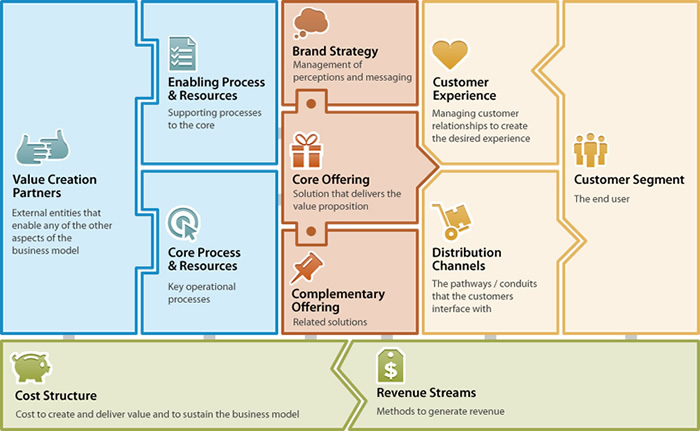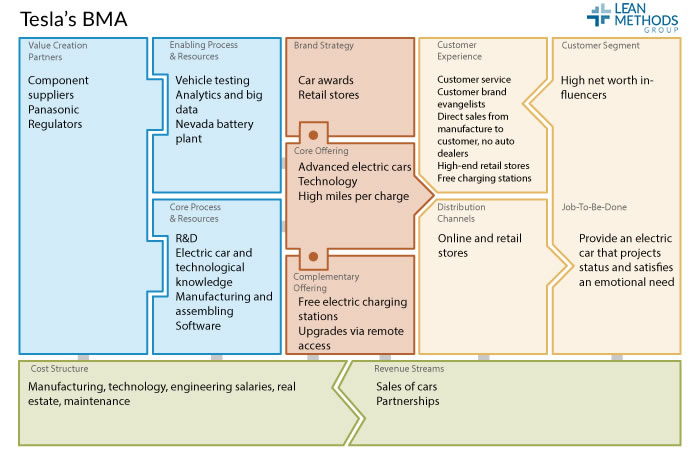Mining Your Business Model for Innovation Opportunities
By Derek Bennington
While product innovations get a lot of attention, that’s not actually where most of the long-lasting innovations come from. They come from within elements of business models, such as distribution channels, core processes, the customer experience and revenue models. Companies interested in creating long-lasting competitive advantage have to look across their business model for innovation opportunities.
The Business Model Architecture is a method to analyze and design how a business creates, delivers and captures value. It is a form of the business model canvas; however, the BMA’s structure was developed analyzing over five different business model frameworks. The combined knowledge developed the framework of the Lean Method Group’s Business Model Architecture, which is comprised of 11 boxes, each integrated together.

Business Model Architecture
Value Creation Partners
External people, businesses or resources that are a primary piece of developing value. Without these partners, the value decreases or is eliminated completely.
Enabling Processes and Resources
These processes, resources and activities are what create the foundation for the business to establish a core process.
Core Processes and Resources
These are the key operational processes, resources and activities that the business does that drives the value. Without these, the value simply cannot be created and the business model disintegrates.
Brand Strategy
Brand Strategy is how perceptions are managed and how the business interacts and communicates with the customer. This has a strong connection to Customer Experience.
Core Offering
This is the solution that carries the majority of the value proposition. Without a strong core offering, the business cannot build a sustainable business model.
Complementary Offering
These offerings become in-addition to, or a part of, the core offering. These can be extra features or benefits that the customer may see as value added, thus increasing the value of the overall offering.
Customer Experience
Managing the customer experience is crucial to a successful model. Brand Strategy and the offering have a tremendous impact, and a business needs to manage this experience to be memorable. This can also be a business differentiator that many other businesses may overlook.
Distribution Channels
These channels are how the customer consumes the offering, which can be delivered digitally, physically or in another manner. The easier it is for the customer to find and consume the offering, the better the experience can be.
Customer Segment
This is the end customer. However, an offering can have multiple different customer segments, so it is important to separate out the segments and explicitly identify them. In addition, the business should identify each customer’s Job To Be Done (JTBD). The reason there are multiple segments, or even one, is because a customer needs to accomplish something, and they are looking to use your offering to handle the need.
Cost Structure
Whatever it takes to create, deliver and capture the value can be a cost. Whether it be explicit costs, direct costs, indirect costs or the like, a business model needs to identify the components of costs, because in the end, profit is only created by having a lower cost to revenue.
Revenue Streams
This is all the ways a business is compensated, monetarily, by the end customer by delivering and consuming the offering.
Example: Tesla’s Business Model
Tesla’s business model is derived from a unique strategy: develop high-end expensive electric luxury supercars for the wealthy, use those profits to drive R&D, and in the future be able to develop a $35,000 electric vehicle for the masses. To deliver on that strategy, Tesla flips the current traditional auto market on its head.
Tesla’s business model is derived from a unique strategy. You can read Elon Mosk’s original master plan here.
The end product is an electric luxury car that combines the best of electrical technology, design and performance. The Tesla Model S, the flagship car, has won multiple design awards and has been proven to be the fastest 0 to 60mph sedan in history. The vehicle’s technology is cutting edge, allowing Tesla to upgrade and remedy many issues remotely, and a battery system that provides over 250 miles per charge is not shabby either, along with free charging stations across the United States, Asia and Europe.
At the crux of Tesla’s business model are two elements: Tesla sells directly from the manufacturer to the customer, so there are no auto-dealer middlemen, and Tesla owns and operates beautifully designed retail stores, similar to Apple, in upscale locations. This setup delivers the best experience and value to the customer, and customers receive unparalleled service. Tesla’s brand strategy hinges here, as Tesla believes the traditional auto-dealer diminishes value and brand image—the exact same reasons why Apple has its own stores. Tesla and Apple can control the customer experience and brand.
Despite the deviation from the traditional dealer model, Tesla still makes money simply by selling cars. Intellectual property is typically another area of revenue, but recently, Tesla has made all of the battery technology intellectual property, among others, public; even though it is keeping some IP to itself, releasing the battery technology is revolutionary to say the least, especially since the batteries are a key element of Tesla’s competitive advantage. Tesla believes this move of making the IP public will help accelerate the adoption of electric vehicles.
Put in the context of the Business Model Architecture, here’s a look at Tesla’s 11 components:

Tesla’s Business Model Architecture
Derek Bennington is a former associate at the Lean Methods Group, where he supported research and development of strategy and operational initiatives. He is an Advanced Kirton-Adaption-Innovation (KAI) certified practitioner and holds a TRIZ Associate certification from the Altshuller Institute.

